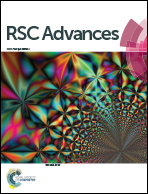New sterically hindered tin(iv) siloxane precursors to tinsilicate materials: synthesis, spectral, structural and photocatalytic studies†‡
Abstract
A series of sterically hindered tin(IV) siloxanes were synthesized by the reaction between tris(tert-butoxy)silanol/tri-phenylsilanol and organotin chlorides {[(tBu)2Sn(OSi(OtBu)3)2] (1), [(tBu)2Sn(OSi(OtBu)3)Cl] (2), [(n-Bu)2Sn(OSi(OtBu)3)2] (3), [(n-Bu)2Sn(OSi(OtBu)3)Cl] (4), [(Me)2Sn(OSi(OtBu)3)2] (5), [(Me)2Sn(OSi(OtBu)3)Cl] (6), [(tBu)2Sn(OSiPh3)2] (7), [(tBu)2Sn(OSiPh3)Cl] (8) whereas tBu = tertiary butyl; n-Bu = butyl; Me = methyl}. All the compounds were characterized by analytical and spectroscopic (FT-IR and 1H, 13C, 29Si, 119Sn NMR) methods. Compounds 1 and 7 were structurally characterized by single-crystal X-ray crystallography. The coordination geometry of tin (SnO2C2) is slightly distorted from tetrahedral due to sterically crowded ligands around the tin atom. In order to convert tinsilicate materials, compounds 1 and 3 were selected for thermolysis to give identical SnO2·2SiO2 materials at low temperature (∼350 °C). The degradation was investigated by thermal analysis (TGA/DTA), both compounds having butyl groups which facile eliminate to butene gas via a β-hydride elimination process (∼250 °C). The molecular route to oxide materials at low temperature described here represents an alternative to the sol–gel technique. The tinsilicate material was examined by several techniques including infrared, powder X-ray diffraction analysis (PXRD), scanning electron microscopy (SEM) and energy dispersive X-ray (EDX). The optical band gap of the material has been studied by UV-vis-NIR spectroscopy and the result is a low band gap value (Eg = 2.549 eV) due to the silicon oxide mixed with tin oxide. The prepared material acts as photocatalyst for the degradation of methylene blue (MB).


 Please wait while we load your content...
Please wait while we load your content...